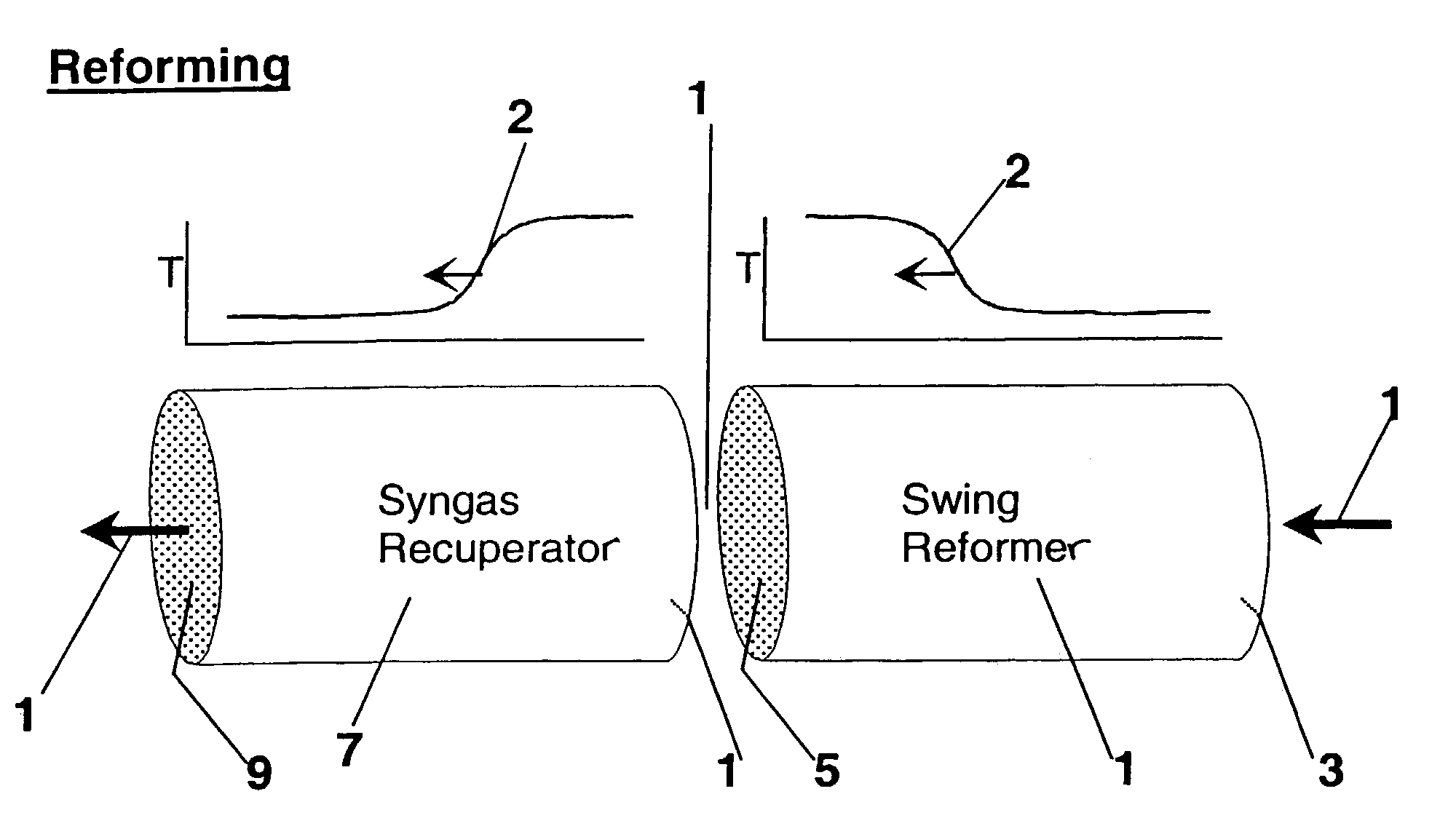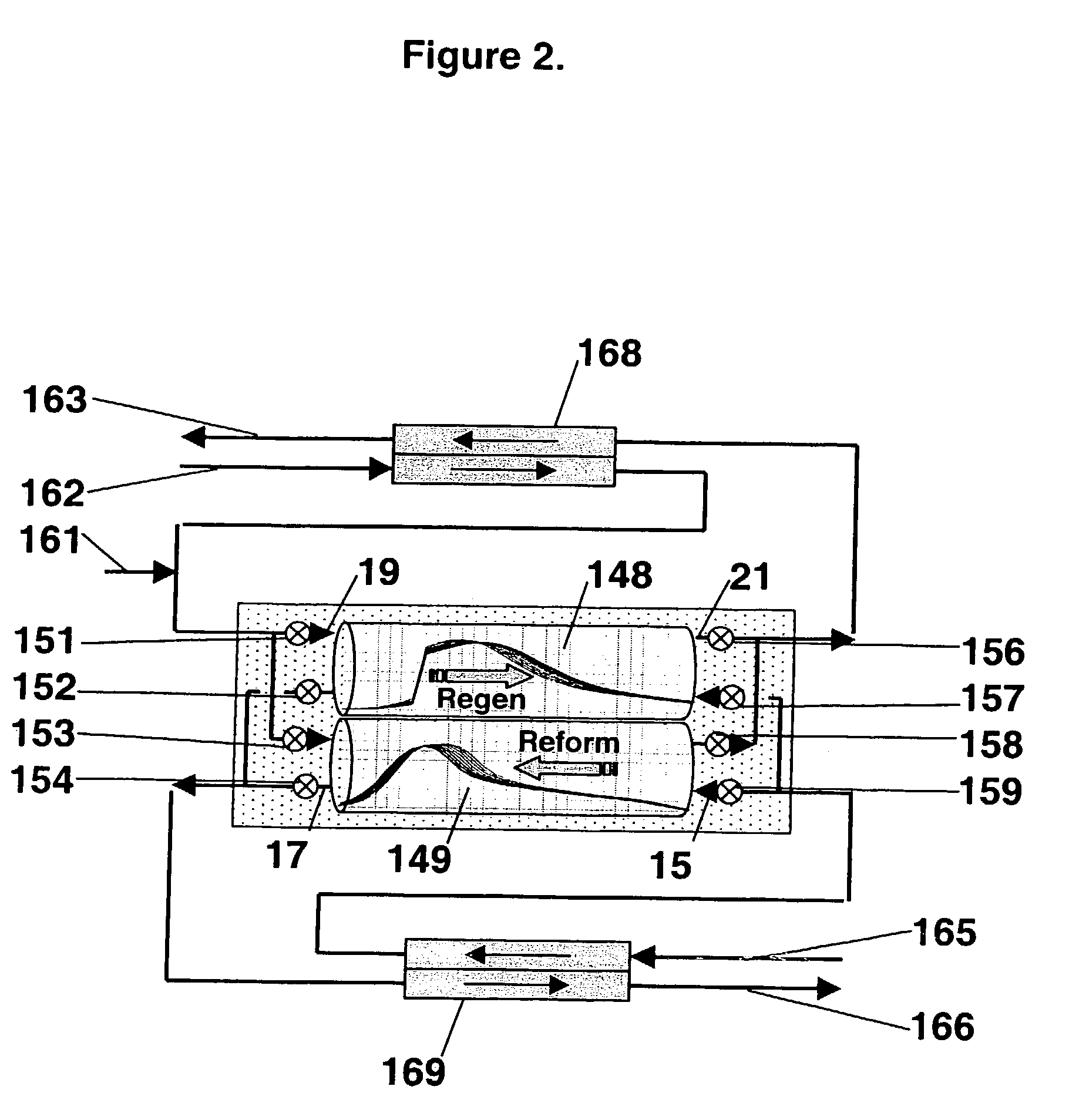Pressure swing reforming
a technology of pressure swing and reforming, which is applied in the direction of indirect heat exchangers, combustible gas production, lighting and heating apparatus, etc., can solve the problems of low productivity, limiting the economic attractiveness of the process, and excessive heat generation, so as to achieve even more efficient process and high pressure synthesis gas
- Summary
- Abstract
- Description
- Claims
- Application Information
AI Technical Summary
Benefits of technology
Problems solved by technology
Method used
Image
Examples
example 1
[0064]Synthesis gas is produced in a 7.62 cm diameter pressure swing reformer (PSR) bed composed of two zones, an 8.47 cm long reforming zone and a 4.23 cm long recuperating zone. The bed packing material of the zones comprises of 60 ppi ceramic foam monolith, having a pore fraction of 80% and a heat transfer surface area of 115 cm2 / cm3. The cycle time is 6 seconds, 3 seconds for regenerating and 3 seconds for reforming. The reforming bed is preheated to 1300° C. by introducing an oxygen-containing gas at 375° C. and 2 atm, and combusting with 1.86 g CH4 fuel, which is fed at the interface of the beds. Products of combustion include O2-depleted air, H2O and CO2. During the reforming step, steam and CH4 are fed into the reforming bed at 375° C. and 3 atm. Reforming produces H2, CO, CO2, H2O and CH4. The results of this example are shown in Table 1.
[0065]
TABLE 1ReformingReformingCombustionCombustiong / cyclefeedproductFeedproductH2O14.346.34—4.25O2——25.1717.73N2——93.0592.92CO2—2.46—5.18...
example 2
[0066]Synthesis gas is produced in a 20 cm diameter PSR bed composed of two zones, a 12 cm long reforming zone and a 6 cm long recuperating zone. The bed packing material is comprised of ⅛″ spherical ceramic beads with a 0.35 void fraction and a heat transfer surface area of 12.3 cm2 / cm3. The cycle time is 60 seconds, 30 seconds for regenerating and 30 seconds for reforming. The reforming bed is preheated to 1200° C. by flowing a mixture of air and flue gas at 450° C. and 1.5 atm, and combusting with 56 g CH4 fuel, which is fed at the interface of the beds. Products of combustion include O2-depleted air, H2O and CO2. During the reforming step, steam and CH4 are fed into the reforming bed at 450° C. and 12 atm. Reforming produces H2, CO, CO2, and H2O. The results of this example are shown in Table 2.
[0067]
TABLE 2ReformingReformingCombustionCombustiong / cyclefeedproductFeedproductH2O408184312438O2——2241N2——26902689CO2—56382541CH4181456—CO—270——H2—70——
PUM
 Login to View More
Login to View More Abstract
Description
Claims
Application Information
 Login to View More
Login to View More - R&D
- Intellectual Property
- Life Sciences
- Materials
- Tech Scout
- Unparalleled Data Quality
- Higher Quality Content
- 60% Fewer Hallucinations
Browse by: Latest US Patents, China's latest patents, Technical Efficacy Thesaurus, Application Domain, Technology Topic, Popular Technical Reports.
© 2025 PatSnap. All rights reserved.Legal|Privacy policy|Modern Slavery Act Transparency Statement|Sitemap|About US| Contact US: help@patsnap.com



